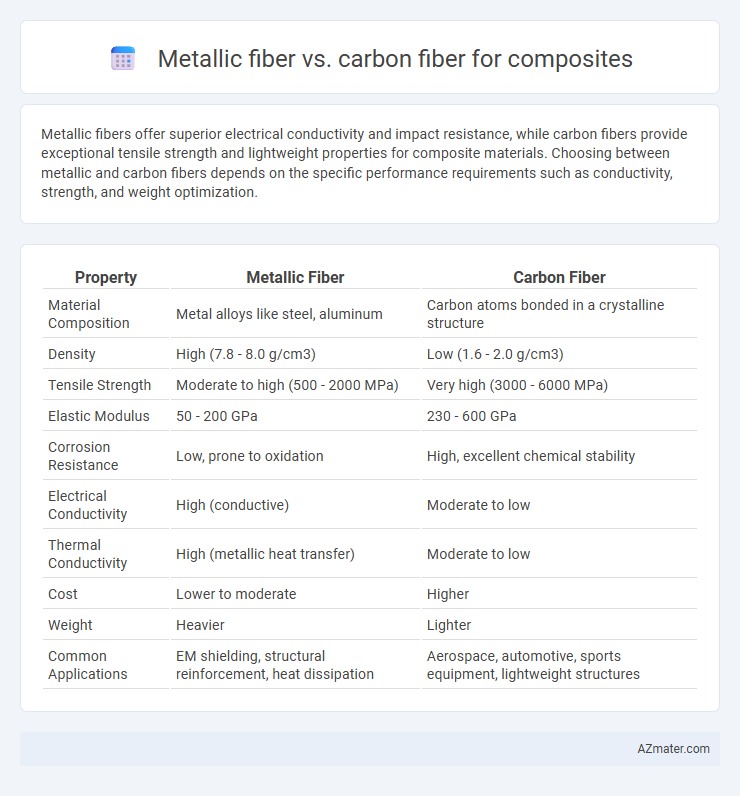Metallic fibers offer superior electrical conductivity and impact resistance, while carbon fibers provide exceptional tensile strength and lightweight properties for composite materials. Choosing between metallic and carbon fibers depends on the specific performance requirements such as conductivity, strength, and weight optimization.
Table of Comparison
| Property | Metallic Fiber | Carbon Fiber |
|---|---|---|
| Material Composition | Metal alloys like steel, aluminum | Carbon atoms bonded in a crystalline structure |
| Density | High (7.8 - 8.0 g/cm3) | Low (1.6 - 2.0 g/cm3) |
| Tensile Strength | Moderate to high (500 - 2000 MPa) | Very high (3000 - 6000 MPa) |
| Elastic Modulus | 50 - 200 GPa | 230 - 600 GPa |
| Corrosion Resistance | Low, prone to oxidation | High, excellent chemical stability |
| Electrical Conductivity | High (conductive) | Moderate to low |
| Thermal Conductivity | High (metallic heat transfer) | Moderate to low |
| Cost | Lower to moderate | Higher |
| Weight | Heavier | Lighter |
| Common Applications | EM shielding, structural reinforcement, heat dissipation | Aerospace, automotive, sports equipment, lightweight structures |
Introduction to Composite Materials
Metallic fibers and carbon fibers serve distinct roles in composite materials, enhancing mechanical properties through their unique characteristics. Metallic fibers provide excellent electrical conductivity, impact resistance, and thermal stability, making them suitable for applications requiring durability and energy absorption. Carbon fibers offer high strength-to-weight ratios, superior stiffness, and corrosion resistance, ideal for lightweight structural components in aerospace and automotive industries.
Overview of Metallic Fibers
Metallic fibers, composed primarily of steel, aluminum, or copper alloys, offer enhanced electrical conductivity and superior thermal resistance compared to carbon fibers in composite materials. They provide excellent impact resistance, durability, and electromagnetic shielding, making them ideal for structural applications requiring toughness and conductivity. While heavier than carbon fibers, metallic fibers improve composite flexibility and corrosion resistance under harsh environmental conditions.
Understanding Carbon Fibers
Carbon fibers exhibit superior tensile strength and stiffness compared to metallic fibers, making them ideal for high-performance composite materials in aerospace and automotive industries. These fibers are composed primarily of carbon atoms bonded in a crystalline formation, providing exceptional durability, lightweight properties, and resistance to corrosion. Their ability to maintain structural integrity under extreme conditions makes carbon fibers a preferred choice over metallic fibers for advanced composite applications.
Mechanical Properties: Strength and Stiffness
Carbon fiber composites exhibit superior tensile strength and stiffness compared to metallic fiber composites, making them ideal for high-performance applications requiring lightweight materials with exceptional rigidity. Metallic fibers, such as steel or aluminum, offer higher impact resistance and better ductility but generally lower specific strength and stiffness than carbon fibers. The choice between metallic and carbon fiber reinforcements depends on balancing mechanical property demands like strength-to-weight ratio, stiffness, and toughness in composite material design.
Weight and Density Comparison
Metallic fibers typically have a density ranging from 2.7 to 8 g/cm3 depending on the metal type, whereas carbon fibers exhibit much lower densities around 1.6 to 2.0 g/cm3, making carbon fiber composites significantly lighter. The higher density of metallic fibers contributes to increased weight in composite structures, influencing applications where weight reduction is critical. Carbon fiber composites offer superior strength-to-weight ratios due to their low density and high tensile strength, thereby outperforming metallic fiber composites in lightweight design requirements.
Corrosion and Environmental Resistance
Metallic fibers in composites typically exhibit lower corrosion resistance compared to carbon fibers, as metals are prone to oxidation and rust in harsh environmental conditions. Carbon fibers demonstrate superior environmental resistance, maintaining structural integrity and performance in moisture, chemicals, and UV exposure without significant degradation. The hydrophobic nature and chemical stability of carbon fibers make them ideal for applications requiring long-term durability in corrosive or variable environments.
Cost and Manufacturing Considerations
Metallic fibers generally offer lower material costs compared to carbon fibers, making them a more budget-friendly option for composite manufacturing. The production process for metallic fiber composites tends to be less complex, allowing for faster fabrication and reduced labor expenses. However, carbon fiber composites provide superior strength-to-weight ratios, which can justify higher costs in performance-critical applications despite more intricate manufacturing techniques.
Common Applications and Industry Uses
Metallic fibers are extensively used in electromagnetic interference (EMI) shielding, wearable technology, and conductive composites due to their excellent electrical conductivity and corrosion resistance. Carbon fibers dominate aerospace, automotive, and sporting goods industries for lightweight, high-strength, and stiffness composites that enhance performance and fuel efficiency. Both fibers serve crucial roles in advanced composite materials where specific mechanical and electrical properties are required, with carbon fibers preferred for structural applications and metallic fibers favored for functional applications like conductivity and shielding.
Design Flexibility and Performance
Metallic fibers exhibit superior ductility and impact resistance, enhancing composite design flexibility through easier shaping and forming compared to carbon fibers, which are inherently brittle but offer higher tensile strength and stiffness. Carbon fibers provide exceptional strength-to-weight ratios and fatigue resistance, making them ideal for high-performance applications demanding lightweight and rigid structures. The choice between metallic and carbon fibers in composites depends on balancing design adaptability with required mechanical performance metrics.
Conclusion: Choosing the Right Fiber for Your Composite
Metallic fibers offer superior electrical conductivity and impact resistance, making them ideal for applications requiring enhanced durability and electromagnetic shielding. Carbon fibers provide exceptional strength-to-weight ratio and stiffness, suitable for lightweight structural components in aerospace and automotive industries. Selecting the right fiber depends on specific performance needs, cost constraints, and the intended application environment of the composite material.

Infographic: Metallic fiber vs Carbon fiber for Composite
 azmater.com
azmater.com